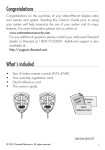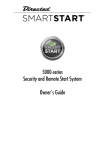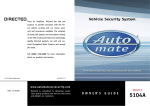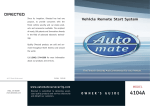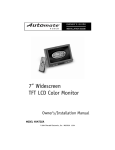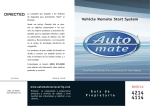Download Automate AM7.5 Instruction manual
Transcript
AM7 Owner's Guide © 2010 Directed Electronics. G5103 2010-07 Congratulations Congratulations on the purchase of your state-of-the-art security/keyless and remote start system. Reading this Owner’s Guide prior to using your system will help maximize the use of your system and its many features. For more information please visit us online at: www.automatecarsecurity.com. For any additional questions please contact your authorized Directed dealer or contact Directed at 1-800-753-0600. Additional support is also available at: http://support.directed.com Important information Government Regulations and Safety information Read the Government Regulations and Warning! Safety First sections of this manual prior to operating this system. Warning! Failure to heed this information can result in death, personal injury or property damage and may also result in the illegal use of the system beyond its intended purpose. Replacement Remote controls If additional remote controls are desired, please see your authorized dealer or visit us at www.directedstore.com to order. Your 1-way part number is 474A. Contents Congratulations ................................................................................................ ii Important information ........................................................................................ ii Replacement Remote controls ..................................................................... ii Getting Started .................................................................................................3 System maintenance..................................................................................3 Battery Replacement..................................................................................3 1-way Remote Control .......................................................................................3 Control Center..........................................................................................4 Basic Commands ..............................................................................................5 Arm/lock .................................................................................................5 Disarm/unlock..........................................................................................5 AUX ........................................................................................................5 Remote start .............................................................................................6 Advanced Commands .......................................................................................7 Additional auxiliary functions. ....................................................................7 Timer mode* ............................................................................................7 Short-run turbo mode* ...............................................................................7 Optional rear window defogger* ...............................................................7 Temperature Start mode* ...........................................................................8 Remote and System operations ...........................................................................9 Passive arming/locking .............................................................................9 Warn away® response (security only) ..........................................................9 Triggered response (security only) ..............................................................9 Multi-level security arming (security only)....................................................10 Arming while driving (security only) ..........................................................11 High security disarm (security only) ...........................................................11 System Override .....................................................................................12 Valet mode ............................................................................................12 Panic Mode ...........................................................................................13 Remote start ...........................................................................................13 Optional rear window defogger ...............................................................15 Timer Mode ..........................................................................................15 Short run/turbo mode .............................................................................16 Temperature Start Mode ..........................................................................16 Valet take-over ........................................................................................16 Power saver mode ..................................................................................17 Safety features ................................................................................................18 Starter-anti-grind circuitry .........................................................................18 Disabling the remote start system ..............................................................18 Shut down inputs ....................................................................................18 Diagnostics (security only) ................................................................................19 Arming diagnostics .................................................................................19 Disarming diagnostics .............................................................................19 Nuisance Prevention® Circuitry ................................................................19 Programming options.......................................................................................21 Government Regulations ..................................................................................24 Warning! Safety First .......................................................................................25 Caution .................................................................................................26 Patent Information ...........................................................................................27 Getting Started System maintenance The system requires no specific maintenance beyond battery replacement for the remote controls. Your 1-way remote control is powered by a coin cell battery (CR-2032) that can be purchased at most retailers. The operating range diminishes as the battery weakens. Battery Replacement Locate the small slot on the side of the remote control. Insert a small slotted screwdriver or equivalent tool into slot and pry the case apart. Replace battery while verifying the correct polarity and then snap case together. 1-way Remote Control Feature Description Transmit LED On (flashes) during remote control activity Command buttons (4) Used to perform arming/locking, disarming/unlocking, auxiliary channel and remote start commands © 2010 Directed Electronics. All rights reserved. 3 Control Center Button Antenna LED The Control Center, typically located on the upper part of the front windshield receives commands or messages from your system. It consists of: • • • The In-vehicle system antenna. The control center LED: a visual indicator of the system’s status. The control center button: for placing the system into Valet Mode* and to perform the Emergency Override* operation. * See Remote and System Operations section for details. 4 © 2010 Directed Electronics. All rights reserved. Basic Commands Arm/lock Press and release The alarm arms, doors lock (if connected), and the siren/horn sounds and parking lights flash once. If Valet mode* is On, the doors lock. Exit Valet mode to arm/lock the alarm normally. To Arm/lock and Panic Press and hold The alarm Arms (or Locks in Valet) and, after 2 seconds, sounds the siren/horn and flashes the parking lights. Disarm/unlock Press and release The alarm disarms, doors unlock (if connected), and the siren/horn sounds and parking lights flash twice. Turns panic off if on. If Valet mode* is On, the doors unlock. AUX Press and release Perform before the Arm/lock or Disarm/unlock command to use the remote control in Silent Mode™. Note: The Warn away response to lighter impacts is bypassed if the system is armed using silent mode. this ensures that no chirps are emitted by the siren in an area you want chirp -free but the system is fully capable of triggering. © 2010 Directed Electronics. All rights reserved. 5 For optional function (trunk release) Press and hold Activates the Aux output, such as trunk release or an expansion function that you have added to your system. The auxiliary output controls: . Remote start Press and release Activates (or if On, deactivates) the remote starter. The engine and parking lights turn On. * 6 See Remote and System Operations for details. © 2010 Directed Electronics. All rights reserved. Advanced Commands Additional auxiliary functions. Press and buttons simultaneously Activates an optional auxiliary convenience or expansion function that you have added to your system. The auxiliary output controls Press and buttons simultaneously Activates an optional auxiliary convenience or expansion function that you have added to your system. The auxiliary output controls Press and buttons simultaneously Activates an optional auxiliary convenience or expansion function that you have added to your system. The auxiliary output controls Timer mode* Press and buttons simultaneously Activates timer mode. Short-run turbo mode* Press and buttons simultaneously Activates short-run timer mode. Optional rear window defogger* Press and and buttons simultaneously Activates the optional Rear window defogger. © 2010 Directed Electronics. All rights reserved. 7 Temperature Start mode* Press and and buttons simultaneously Activates the Temperature Start mode. Warning! Car should be parked in a well ventilated area when using this feature. * 8 See Remote and System Operations for details. © 2010 Directed Electronics. All rights reserved. Remote and System operations Passive arming/locking The system can be programmed to arm/lock itself automatically (called passive arming/locking). If the system is programmed for passive arming/ locking, it will automatically arm/lock 30 seconds after the ignition is turned off and the system detects that you have left the vehicle by opening and closing a door. Whenever the system is in its 30-second passive arming/locking countdown, the status LED will flash twice as fast as it does when the system is armed/locked. At the 20-second point of the countdown, the siren/horn will sound to indicate that the system is about to arm/lock. At the 30-second point, the parking lights will flash to indicate that the system is armed/locked. Note: If any protected entry point (such as a door or a switch-protected trunk or hood) is open, the system will not passively arm/lock (unless forced passive arming/locking is programmed on). Warn away® response (security only) • Shock Sensor - Light impacts to the vehicle will flash the vehicle lights and sound the siren/horn for a few seconds. Triggered response (security only) A Triggered Response can be activated by any of the triggers listed below. The default Triggered Response duration is 30 seconds but can be programmed from 1-180 seconds by your installer. • Shock Sensor Trigger - Heavy impacts to the vehicle will instantly sound the siren/horn and flash the lights for the programmed duration and report Zone 2. • Door Trigger - If a door is opened the siren/horn will sound and © 2010 Directed Electronics. All rights reserved. 9 • • • lights flash for three seconds, then the siren/horn will sound continuously and the lights will flash for the programmed duration and report Zone 3. The three seconds allow the user time to disarm/ unlock the system with a minimum of noise should a door be opened inadvertently while the system is armed/locked. Hood Trigger - Opening the hood will sound the siren/horn, flash the lights for the programmed duration, and report Zone 1. Trunk Trigger - Opening the trunk (if connected) will instantly sound the siren/horn and flash the lights for the programmed duration and report Zone 4. Ignition Trigger - Turning on the ignition key will trip the same progressive response as the door trigger and report Zone 5. Multi-level security arming (security only) Multi-Level Security Arming allows you to select which of the system’s inputs or sensors will be active and which will be bypassed when the system is armed. Pressing again within five seconds of arming the system activates the Multi-level security feature. Each time is pressed, a different security level is selected. To select the security levels: Press once: The siren chirps once. The system is armed with all zones active. Press a second time within five seconds. The siren chirps twice followed by a long chirp. Zone 2 is now bypassed. Press a third time within five seconds. The siren chirps three times followed by a long chirp. Zone 4 is now bypassed. 10 © 2010 Directed Electronics. All rights reserved. Press a fourth time within five seconds. The siren chirps four times followed by a long chirp. Zones 2 and 4 are now bypassed. Press a fifth time within five seconds. The siren chirps five times followed by a long chirp. All input zones, except the ignition are now bypassed. Note: Multi-level security arming only applies to a single arming cycle. Once the system is disarmed and then re-armed, all the zones will be active again. Arming while driving (security only) Your security system can be armed while driving the vehicle. Press on the remote control for two seconds while the vehicle is running. The siren/horn will sound once to indicate that the security system is armed, and then once more to indicate that the ignition is on. The system will not respond to any input except the door triggers, and the starter kill relay (if installed) will not be activated. Once you have arrived at your destination, the system will disarm when the ignition is turned off. The siren/horn will sound twice and the LED will then stop flashing. The system can also be disarmed at any time by pressing High security disarm (security only) This security system offers High Security Disarm. High Security Disarm is a feature that makes it possible to silence and reset the system while it is triggering, without disarming the system. If the system is triggered and the siren has been sounding for longer than six seconds, pressing on the remote silences the siren while keeping the system in the armed state. The system does not disarm, but resets. Pressing again after silencing the system will disarm the system. © 2010 Directed Electronics. All rights reserved. 11 If the system is triggered and the siren has been sounding for less than six seconds, pressing disarms the system. The six second timer is provided for your convenience, in case the system is accidentally triggered. System Override If your remote control is lost or damaged, you can manually disarm your vehicle security system or disable an optional starter kill. To disarm or disable the system without a remote control, you must have the vehicle’s ignition key. To disarm/disable the system: 1. Turn the ignition to the ON position. 2. Press the control center button the preset number of times (one to five times) within 15 seconds. The factory default setting is 1 press. After five seconds, the system will disarm/disable. If the system does not disarm/disable, you may have waited too long. Start over by turning the ignition off and on. Number of Presses_____________________________________ Important: The control center button can be programmed to respond to 1-5 presses for the disarm/disable function. You must check with the installer to verify the programming for your individual unit. Valet mode You can prevent your system from automatically arming/locking and triggering by using Valet Mode. This is very useful when washing the 12 © 2010 Directed Electronics. All rights reserved. vehicle or having it serviced. In Valet Mode, the system/starter kill will not arm/enable, even with the remote control, but all convenience functions (door locks, trunk release, etc.) will continue to work normally. To enter or exit Valet Mode: 1. Turn the ignition on. 2. Turn the ignition off. 3. Press and release the control center button within 10 seconds. To enter or exit Valet Mode using the remote control: 4. Open any vehicle door. 5. Press . 6. Press and then press again. The status LED lights solidly if you are entering Valet Mode, and goes off when you exit Valet Mode. Panic Mode if you are threatened in or near your vehicle, you can attract attention by triggering the system with your remote control. Press and hold for two seconds. The siren sounds and the parking lights flash for the programmed siren duration. To stop panic made at any time, press on the remote control again. Remote start This feature allows you to remotely start and run your vehicle for a programmable period of time. This makes it possible to warm up the engine, as well as adjust the interior temperature of the vehicle with the climate control system. If interior heating or cooling is desired, the climate controls must be preset, and the fan blower must be set to the desired level prior to remote starting the vehicle. © 2010 Directed Electronics. All rights reserved. 13 Warning! (1) Never remote start your vehicle when the keys are in the ignition, except when performing Valet® Take-Over, and (2) Never start the vehicle if it is not in PARK or NEUTRAL To remote start the vehicle: • Press on the remote control once. The parking lights flash to confirm that the vehicle will attempt to start. With gas vehicles the engine starts 4 seconds after the parking lights flash. With diesel vehicles the engine starts when the WAIT-TO-START indicator on the dashboard goes out or the programmed delay has ended. Once the vehicle has started, it runs for the pre-programmed period of time or until a shutdown input is triggered. Warning! It is unsafe to operate a vehicle’s motor in a garage or other closed off area. Breathing the exhaust from the vehicle is hazardous to your health. Never activate the remote start in an enclosed space. When you are ready to drive the vehicle: 1. 2. Insert the ignition key and turn it to the On position. Press the brake pedal. Note: If the brake pedal is pressed before the key is in the ON position, the engine will shut down. While the vehicle is running during remote start operation, the system monitors the vehicle and automatically shuts down the engine if the system receives any of the following: 14 © 2010 Directed Electronics. All rights reserved. • • • • • The brake pedal is pressed The hood is opened The shutdown toggle switch is put into the Off position. Runtime (12,24, or 60 minutes) expires Remote control button is pressed once. Optional rear window defogger Pressing the , and simultaneously activates/deactivates the optional rear window defogger. The parking lights flash two times and the rear defogger is no longer active when the vehicle is remote started. When the same procedure is repeated, the defogger activates and the parking lights flash three times. If the vehicle interior temperature is greater than 55°F when the remote start is activated, the rear defogger does not turn on. Timer Mode When you activate timer mode the system automatically starts the vehicle every three hours for a maximum of 6 starts. The pre-programmed engine runtime is 12 minutes. • Press and to activate timer mode. The parking lights flash four times, and after a 1 second delay, the engine starts. • To shutdown the engine, press the button. The engine will shutdown while the system remains in timer mode and will continue to start every 3 hours until the system reaches the maximum amount of starts or is cancelled by turning on the ignition, activating the brake, or turning off the shutdown toggle switch. • The parking lights flash 4 times indicating timer mode is exited. Important! Timer Mode should be used only in open areas. Never start and run the vehicle in an enclosed space such as a garage or carport. © 2010 Directed Electronics. All rights reserved. 15 Short run/turbo mode Short run turbo mode keeps the engine running after arriving at your destination for a programmable period of 1, 3, 5 or 10 minutes. This allows the system’s timer to conveniently cool down the turbo after you have left the vehicle. To activate: 1. Park the vehicle and set the parking brake. 2. Remove your foot from the brake pedal and leave the engine running. 3. Press and release the and buttons at the same time. The lights will flash to indicate the remote start has entered short run turbo mode. 4. Turn off the key, the engine will keep running. 5. Exit and secure the vehicle. The engine will turn off after the programmed run time. Temperature Start Mode Pressing the , and simultaneously activates the Temperature Start mode. The parking lights flash fast four times to confirm activation. The engine does not start once activated, it starts when the vehicle interior temperature drops below 0°F. Deactivate Temperature Start mode by pressing the same buttons again or turning the vehicle ignition on. The parking lights flash slowly four times to confirm deactivation Valet take-over The Valet Take-Over feature allows the vehicle to remain running after the key has been removed from the ignition. This feature is useful for occasions when you wish to exit and lock the vehicle for short periods of time, but would like to leave the motor running and the climate 16 © 2010 Directed Electronics. All rights reserved. controls on. To perform Valet Take-Over: 1. Before turning off the engine, press and release on the remote control (or press and release the optional momentary switch). Then wait five seconds. 2. Turn the ignition key to the OFF position. (The engine will stay running.) The engine will run until the pre-programmed time elapses or a shut-down input is received. (See the previous Remote Start section for a complete list of shut-down inputs.) This feature will not work if the brake pedal is being pressed. Power saver mode Your system will automatically enter Power Saver Mode while armed/ locked or in Valet Mode, after a period of time in which no operation has been performed. To reduce power consumption the control center status LED modifies its output if the vehicle is parked for an extended period. When Armed, the flashing is reduced after 24 hours. When Valet mode is On, the LED turns off after 1 hour and resets each time the ignition is turned off. © 2010 Directed Electronics. All rights reserved. 17 Safety features This system has several important safety features to ensure proper operation of the motor and prevent accidental damage to the engine or its components. Starter-anti-grind circuitry Whenever the vehicle is remote started, advanced anti-grind circuitry prevents the starter from engaging, even if the key is turned to the start position. This prevents damage to the starter motor if the key is turned to the start position during remote start operation. Important: The Fail Safe starter kill option must be installed for this feature to work. Disabling the remote start system This feature allows your system’s remote start unit to be temporarily disabled to prevent the vehicle from being remote started accidentally. This feature is useful if the vehicle is being serviced or stored in an enclosed area. To disable the remote start, move the shutdown toggle switch to the OFF position. The switch can be installed in a location of your choice. Check with your installer for recommended locations. Location of Shutdown Switch____________________________ Shut down inputs This security system uses several inputs to shut down the remote start operation of the motor or prevent remote start if certain inputs are active. The two most important are hood and brake inputs. The hood input will prevent the motor from starting, as well as shut it down, any time the hood is opened. The brake pedal will shut down the motor at any time during remote start operation, as well as preventing the remote start from activating while it is being pressed. 18 © 2010 Directed Electronics. All rights reserved. Diagnostics (security only) The microprocessor at the heart of your system is constantly monitoring all of the switches and sensors connected to it. It is designed to detect any faulty switches and sensors and prevents them from disabling the entire system. The microprocessor will also record and report any triggers that occurred during your absence. Refer to the Table of Zones sections of this guide for diagnostic information. Arming diagnostics When armed by remote command the system runs a status check of the alarm trigger zones. Faulty zones (usually caused by dome light delay or open trunk) are bypassed and reported via the control center LED, while all other trigger zones remain active and are monitored to protect the vehicle. Should a faulty zone self correct (dome light turns off) it becomes active and is then monitored normally. The siren chirps once again a few seconds following the arming chirps as an audible alert, the control center LED flashes in groups to indicate the zone number (see Table of zones). Disarming diagnostics The most recent alarm triggers (if any) are reported when the alarm is disarmed via the siren chirps, parking light and control center LED flashes. The siren chirps 4 times (or 5 times if NPC On), the lights flash 3 times, and the control center LED flashes in groups to indicate the last two zones that were triggered (see Table of Zones). Nuisance Prevention® Circuitry Your system has Directed’s Nuisance Prevention Circuitry (NPC). It prevents annoying repetitive trigger sequences due to faulty door pin © 2010 Directed Electronics. All rights reserved. 19 switches or environmental conditions such as thunder, jackhammers, airport noise, etc. Example: If the alarm triggers three times within a 60-minute period and each time the same sensor or switch triggers the alarm, NPC will interpret those triggers as false alarms. After the third trigger, NPC ignores, or bypasses, that sensor or switch (along with any other sensors or switches sharing the same zone) for 60 minutes. If the bypassed sensor tries to trigger the security system while it is being bypassed, the 60-minute bypass period will start over. This ensures that a sensor that is continually being triggered will remain bypassed. The vehicle doors are protected by NPC differently. If your security system is triggered by an open door for three full cycles, the system will bypass the doors until the trigger ceases. Note: Arming and disarming the system does not reset this function. The only way to reset a bypassed zone is to not have it trigger for 60 minutes, or to turn on the ignition. If testing your system, remember that the NPC programming can cause zones to be bypassed and appear to stop working. If five chirps are heard when disarming, NPC has been engaged. If you wish to clear the NPC memory, turn the ignition on. Table of zones A zone is represented by the number of LED flashes used by the system to identify a particular type of input. Standard input assignments are listed in the following table, along with spaces to write in any optional sensors or switches that have been installed. Warn Away responses are not reported by arming or disarming diagnostics. 20 © 2010 Directed Electronics. All rights reserved. Zone Description 1 Trunk Pin 2 Instant trigger: a heavier impact detected by the shock sensor 3 Door switch trigger 4 Instant trigger: for optional sensors 5 Ignition trigger 6 Hood Pin Dealer installed options Your system stores the last two triggered zones in memory. If your system has been triggered but the LED has been reset by turning on the ignition, your dealer can still recall the last two zones that were triggered. Contact your dealer for details. Programming options Programming options control your system’s normal, operational set-up. Most options do not require additional parts, but some may require installation labor. See your authorized Directed dealer for more details. The following is a list of the programmable options, with the factory settings in Bold. • Active arming (transmitter only) or Passive arming (automatic arming 30 seconds after the last door has been closed). • Arming/disarming siren chirps On or Off. • The ignition controlled door lock feature On or Off: When this feature is programmed on, the doors will lock three seconds after the ignition is turned on, and unlock when the ignition is turned off. If your installer is programming the security system with the Directed Bitwriter, ignition lock and unlock are independent features that can be programmed separately. Important: The vehicle doors must be closed for the ignition lock feature to work. • Passive door locking (with passive arming) or Active door locking (only when arming with the transmitter). Passive locking allows the vehicle’s doors to lock when the security system passively arms (after the 30-second countdown). This feature only works if passive arming has been programmed. • Panic mode Enabled/Disabled when the ignition is turned on. (Some states have laws against sirens sounding in moving cars.) • Forced passive arming On or Off. If your security system is programmed for passive arming and the forced passive arming feature has been programmed on, the system will passively arm after one hour, even if a protected entry has been left open. Forced passive arming ensures that the system will be armed if a door has accidentally been left ajar when leaving the vehicle. When the system passively arms after one hour, the entry point that has been left open, and anything connected to the same zone, is bypassed and cannot trigger the system. However, the remaining inputs to the system are fully operational. • 22 Full trigger response 30 or 60 seconds: This determines how long the full triggered sequence lasts. Some states have laws regulating how long a security system can sound before it is considered a © 2010 Directed Electronics. All rights reserved. nuisance. If your installer is programming the security system with the Directed Bitwriter, the full triggered response can be programmed for any duration ranging from 1 to 180 seconds. • Siren tones and chirp volume. The output of the Revenger™ Soft Chirp™ siren consists of six different tones in sequence. Any of these tones can be eliminated by a dealer, resulting in a unique, easily identifiable siren sound. The chirps can be either full volume or 6 decibels quieter than the full alarm blast. • 12, 24, or 60 minute run time. your system can be programmed to allow the vehicle to run for 12, 24, or 60 minutes when remote started. Can be set up to minute increments by your installer. Note: If your installer is programming the system with the Bitwriter,® the remote start run time may be programmed for any duration ranging from 1 to 60 minutes. • 3, 6, 9, or 12 minute timer mode run time. Your system can be programmed to allow the vehicle to run for 3, 6, 9, or 12 minutes when remote started in timer mode. Can be set from 1 to 16 minutes by your installer. • While the remote start is running the engine, the parking lights Flash on and off, or Come on steadily. • Comfort closure is a programming option which closes the vehicle’s windows after remote locking. © 2010 Directed Electronics. All rights reserved. 23 Government Regulations This device complies with Part 15 of FCC rules. Operation is subject to the following two conditions: (1) This device may not cause harmful interference, and (2) This device must accept any interference received, including interference that may cause undesirable operation. This equipment has been tested and found to comply with the limits for a class B digital device, pursuant to Part 15 of the FCC Rules. These limits are designed to provide reasonable protection against harmful interference in a residential installation. This equipment generates and can radiate radio frequency energy and, if not installed and used in accordance with the instruction manual, may cause harmful interference to radio communications. However, there is no guarantee that interference will not occur in a particular installation. If this equipment does cause harmful interference to radio or television, which can be determined by turning the equipment OFF and ON, the user is encouraged to try to correct the interference by one or more of the following measures: • Reorient or relocate the receiving antenna. • Increase the separation between the equipment and receiver. • Connect the equipment into an outlet on a circuit different from that to which the receiver is connected. • Consult the dealer or an experienced radio / TV technician for help. This device complies with the Industry Canada Radio Standards Specification RSS 210. Its use is authorized only on a no-interference, no-protection basis; in other words, this device must not be used if it is determined that it causes harmful interference to services authorized by IC. In addition, the user of this device must accept any radio interference that may be received, even if this interference could affect the operation of the device. Warning: Changes or modifications not expressly approved by the party responsible for compliance could void the user’s authority to operate this device. 24 © 2010 Directed Electronics. All rights reserved. Warning! Safety First The following safety warnings must be observed at all times: Due to the complexity of this system, installation of this product must only be performed by an authorized Directed dealer. When properly installed, this system can start the vehicle via a command signal from the remote control/transmitter. Therefore, never operate the system in an enclosed area or partially enclosed area without ventilation (such as a garage). When parking in an enclosed or partially enclosed area or when having the vehicle serviced, the remote start system must be disabled using the installed toggle switch. It is the user’s sole responsibility to properly handle and keep out of reach from children all remote control/transmitters to assure that the system does not unintentionally remote start the vehicle. THE USER MUST INSTALL A CARBON MONOXIDE DETECTOR IN OR ABOUT THE LIVING AREA ADJACENT TO THE VEHICLE. ALL DOORS LEADING FROM ADJACENT LIVING AREAS TO THE ENCLOSED OR PARTIALLY ENCLOSED VEHICLE STORAGE AREA MUST AT ALL TIMES REMAIN CLOSED. These precautions are the sole responsibility of the user. Use of this product in a manner contrary to its intended mode of operation may result in property damage, personal injury, or death. (1) Never remotely start the vehicle with the vehicle in gear, and (2) Never remotely start the vehicle with the keys in the ignition. The user must also have the neutral safety feature of the vehicle periodically checked, wherein the vehicle must not remotely start while the car is in gear. This testing should be performed by an authorized Directed dealer in accordance with the Safety Check outlined in the product installation guide. If the vehicle starts in gear, cease remote start operation immediately and consult with the authorized Directed dealer to fix the problem. © 2010 Directed Electronics. All rights reserved. 25 After the remote start module has been installed, contact your authorized dealer to have him or her test the remote start module by performing the Safety Check outlined in the product installation guide. If the vehicle starts when performing the Neutral Safety Shutdown Circuit test, the remote start unit has not been properly installed. The remote start module must be removed or the installer must properly reinstall the remote start system so that the vehicle does not start in gear. All installations must be performed by an authorized Directed dealer. OPERATION OF THE REMOTE START MODULE IF THE VEHICLE STARTS IN GEAR IS CONTRARY TO ITS INTENDED MODE OF OPERATION. OPERATING THE REMOTE START SYSTEM UNDER THESE CONDITIONS MAY RESULT IN PROPERTY DAMAGE OR PERSONAL INJURY. YOU MUST IMMEDIATELY CEASE THE USE OF THE UNIT AND SEEK THE ASSISTANCE OF AN AUTHORIZED DIRECTED DEALER TO REPAIR OR DISCONNECT THE INSTALLED REMOTE START MODULE. DIRECTED WILL NOT BE HELD RESPONSIBLE OR PAY FOR INSTALLATION OR REINSTALLATION COSTS. Caution This product is designed for fuel injected, automatic transmission vehicles only. Use of this product in a standard transmission vehicle is dangerous and contrary the product’s intended use. Patent Information This product is covered by one or more of the following U.S. patents: 303,223 345,711 4,383,242 5,103,221 5,534,845 5,907,195 333,633 347,190 4,438,426 5,117,217 5,572,185 5,914,667 333,634 348,622 4,553,127 5,132,660 5,646,591 5,945,936 333,635 352,685 4,584,569 5,193,141 5,656,997 5,952,933 333,636 383,689 4,794,368 5,245,694 5,712,638 5,990,786 6,093,979 333,795 383,690 4,887,064 5,285,186 5,783,989 340,000 390,830 4,897,630 5,315,285 5,798,711 344,905 392,944 4,922,224 5,357,560 5,872,519 345,317 4,327,444 4,987,402 5,532,670 5,900,806 International Patents: Australia: 694,925 Canada: 1,315,859 and 2,067,099 Taiwan: 91817 Other patents pending © 2010 Directed Electronics. All rights reserved. 27






























